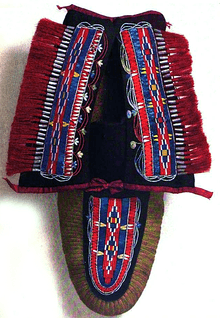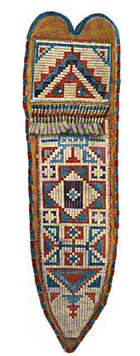Quillwork

Quillwork is a form of textile embellishment traditionally practiced by Native Americans that employs the quills of porcupines as an aesthetic element. Quills from bird feathers were also occasionally used in quillwork.
History

Porcupine quillwork is an art form completely unique to North America. Before the introduction of glass beads, quillwork was a major decorative element used by the peoples who resided in the porcupine's natural habitat,[1] which included indigenous peoples of the Subarctic, Northeastern Woodlands, and Northern Plains. The use of quills in designs spans from Maine to Alaska.[2] Quillworking tools were discovered in Alberta, Canada and date back to the 6th century CE.[3]
Cheyenne oral history, as told by Picking Bones Woman to George Bird Grinnell, says quilling came to their tribe from a man who married a woman, who hid her true identity as a buffalo. His son was also a buffalo. The man visited his wife and son in their buffalo home, and, while among the buffalo, the man learned the art of quilling, which he shared with the women of his tribe.[4]
Joining the Cheyenne Quilling Society was a prestigious honor for Cheyenne women. Upon entering the Society, women would work first on quilling moccasins, then cradleboards, rosettes for men's shirts and tipis, and ultimately, hide robes and backrests.[4]
Porcupine quills often adorned rawhide and tanned hides, but during the 19th century, quilled birch bark boxes were a popular trade item to sell to European-Americans among Eastern and Great Lakes tribes. Quillwork was used to create and decorate a variety of Native American items, including those of daily usage to Native American men and women. These include clothing such as coats and moccasins, accessories such as bags and belts, and furniture attachments such as a cradle cover.[5]
Technique

Quills suitable for embellishment are two to three inches long and may be dyed before use.[1] In their natural state, the quills are pale yellow to white with black tips. The tips are usually snipped off before use. Quills readily take dye, which originally was derived from local plants and included a wide spectrum of colors, with black, yellow, and red being the most common. By the 19th century, aniline dyes were available through trade and made dying easier.[6]
The quills can be flattened with specific bone tools or by being run through one's teeth. Awls were used to punch holes in hides, and sinew, later replaced by European thread, was used to bind the quills to the hides.
The four most common techniques for quillwork are appliqué, embroidery, wrapping, and loom weaving.[7] Appliquéd quills are stitched into hide in a manner that covers the stitches.[1] In wrapping, a single quill may be wrapped upon itself or two quills may be intertwined.[1]
Quills can be appliquéd singly to form curvilinear patterns, as found on Odawa pouches from the 18th century.[8] This technique lends itself to floral designs popularized among northeastern tribes by Ursuline nuns. Huron women excelled at floral quillwork during the 18th and 19th centuries.[9]
Plains quillwork is characterized by bands of rectangles creating geometrical patterns found also in Plains painting.[10] Rosettes of concentric circles of quillwork commonly adorned historical Plains men's shirts, as did parallel panels of quillwork on the sleeves. These highly abstracted designs had layers of symbolic meaning.
The Red River Ojibwe of Manitoba created crisp, geometric patterns by weaving quills on a loom in the 19th century.[11]
Today

Quillwork never died out as a living art form in the Northern Plains. Some communities that had lost their quillwork tradition have been able to revive the art form. For instance, no women quilled in the Dene community of Wha Ti, Northwest Territories by the late 1990s. The Dene Cultural Institute held two workshops there in 1999 and 2000, effectively reviving quillwork in Wha Ti.[12]
The art form is very much alive today. Examples of contemporary, award-winning quillworkers include Juanita Growing Thunder Fogarty, (Sioux-Assiniboine) artist;[13] Dorothy Brave Eagle (Oglala Lakota) of Denver, Colorado;[14] Kanatiiosh (Akwesasne Mohawk) of St. Regis Mohawk Reservation;[15][16] Sarah Hardisty (Dene) of Jean Marie River, Northwest Territories;[17] Leonda Fast Buffalo Horse (Blackfeet) of Browning, Montana;[18] and Deborah Magee Sherer (Blackfeet) of Cut Bank, Montana.[19]
Northern Lakes College of Alberta, Canada teaches a college-level course in quillwork art.
See also
- Hair drop, men's ornaments typically featuring quillwork
Notes
- 1 2 3 4 Gillow and Sentance 223
- ↑ Orchard
- ↑ Dubin 265
- 1 2 Penney and Horse Capture 119
- ↑ Cole, Christina; Herald, Susan (2010). "The History and Analysis of Pre-Aniline Native American Quillwork Dyes". Textile Society of America Symposium Proceedings – via Digital Commons@University of Nebraska-Lincoln.
- ↑ Feest 138
- ↑ Feest 215
- ↑ Vincent 15
- ↑ Vincent 24
- ↑ Feest 140
- ↑ Vincent 28 and 43
- ↑ Marie and Thompson, 29
- ↑ Durbin 279 and 304
- ↑ Melmer, David. "Quillwork: Lakota Style." Indian Country Today. 22 Sept 2004.
- ↑ Native American Quillwork. Native Languages of the Americans. 2008 (retrieved 19 Feb 2009)
- ↑ Roberts, Kathaleen. Native Costume. Archived July 16, 2011, at the Wayback Machine. Journal Santa Fe. 3 Nov 2008. Retrieved 19 Feb 2009.
- ↑ Menicoche, Kevin A. (March 3, 2014). "Kevin A. Menicoche on Condolences On The Passing Of Nahendeh Resident Sarah Hardisty". OpenNWT.
- ↑ Leonda Fast Buffalo Horse: Quillwork. Montana Arts Council. (retrieved 19 Feb 2009)
- ↑ Horse Capture 118-119
References
- Dubin, Lois Sherr. North American Indian Jewelry and Adornment: From Prehistory to the Present. New York: Harry N. Abrams, Inc. Publishers, 1999. ISBN 0-8109-3689-5.
- Feest, Christian F. Native Arts of North America. London: Thames and Hudson, 1992. ISBN 978-0-500-20262-3.
- Gillow, John and Bryan Sentance (1999). World Textiles: A Visual Guide to Traditional Techniques. Thames & Hudson. ISBN 978-0-500-28247-2.
- Horse Capture, John D. et al. Beauty, Honor, and Tradition: The Legacy of Plains Indian Shirts. Washington DC: National Museum of the American Indian, 2001. ISBN 978-0-8166-3947-2.
- Marie, Suzan and Judy Thompson. "Whadoo Themi: Long-Ago People's Packsack: Dene Babiche Bags: Tradition and Revival." Canadian Museum of Civilization Mercury Series. Ethnology Paper 141. 2004: 29
- Orchard, William C. (1916). The Technique of Porcupine-Quill Decoration Among The North American Indians. The Museum of the American Indian Heye Foundation. ISBN 978-0-943604-00-8.
- Penney, David W. and George Horse Capture. North American Indian Art. London: Thames & Hudson, 2004. ISBN 978-0-500-20377-4.
- Vincent, Gilbert T. Masterpieces of American Indian Art from the Eugene and Clare Thaw Collection. New York: Harry N. Abrams, 1995. ISBN 978-0-8109-2628-8.
External links
| Wikimedia Commons has media related to Quillwork. |
- Porcupine and bird quillwork, in the collection of the National Museum of the American Indian
- Substantial material about quillwork from nativetech.org



